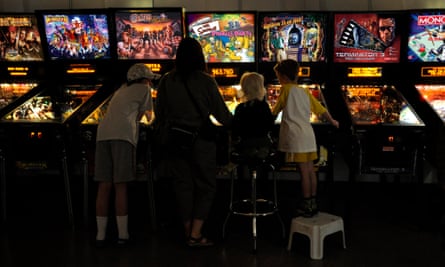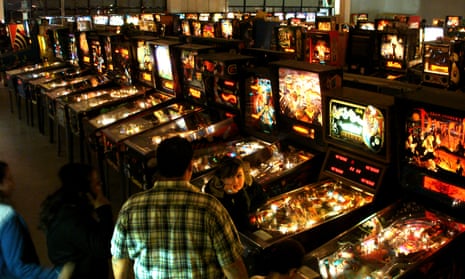Tim Arnold prizes his pinball machines. Customers, not so much.
He bought his first one at age 15 and soon began taking the contraptions apart to reveal their secrets. Later, in college, he discovered he could make more fixing pinball machines than he could ever hope to make in any respectable job.
“So I decided to sail off on that pirate ship,” he said, “and I’ve been doing it ever since.”
Now 60, a wispy bespectacled man with a graying ponytail, Arnold is among the planet’s most prolific pinball collectors, with more than 1,000 machines, many of which are rare.
For years he has run the not-for-profit Pinball Hall of Fame in a 9,000-square-foot industrial palace just a few miles east of the Las Vegas Strip, this city’s better-known realm of high-rollers and bad breaks.
Staffed by volunteers, it’s a buzzing, ringing, tilting, mostly electronic wonderland where ageing pinball aficionados and their kids deposit up to four quarters to play 200 machines that Arnold has refurbished himself, including the prized Williams’ Black Gold, Bally’s Pinball Circus and Recreativos Franco’s Impacto. The proceeds from the machines are donated to the Salvation Army.
Unlike that kid in the 1960s rock anthem by The Who, Arnold isn’t deaf, dumb or blind. Still, he faces a daunting challenge: these days, the old-timers have all retired or died off, leaving few wizards who can manage the machines’ precise workings.
Arnold knows he may be among the last of a pinball breed.
He’s looking for a protege with the skills to take over his arcade empire in an era where the 1970s and 80s electronic circuitry that are the guts of most machines have become as difficult to get as the treasure in a pinball pharaoh’s tomb.
One day, at his cavernous warehouse where the lights are kept off (players prefer darkness to become one with the multicolored light show of their machines), Arnold stands under a workshop light – like a pinball Geppetto – laboring over a 1973 game called Triple X that operated on cogs and gears.
A T-shirt hangs on the wall at the hall of fame says: “I may seem quiet and reserved, but if you mess with me while I am (the word “fixing” is taped over “playing”) pinball, I will break out a level of crazy that will make your nightmares seem like a happy place.”

Passionate and curmudgeonly, this self-proclaimed Director of Things and Stuff wonders if his replacement will ever be found. “You’ve got to ask yourself ‘Is this a Beach Boys operation or a Jan and Dean operation? If a Beach Boy dies, you can just hand somebody a surfboard and a pair of shorts and you go on. But if a Jan or a Dean dies, there goes the act.”
Arnold is searching, of course, for a modern version of his younger self – a kid who fell in love with the pinball machine as a symbol of cultural rebellion.
The game was born in Chicago in the 1930s, where wood from Wisconsin was plentiful for the construction of table-top machines into which a player inserted a penny to launch a ball that bounced off pins before falling into pockets for scoring. The game soon became popular in the city’s vast tavern industry and – like most things in Chicago in those days – was taken over by organized crime and turned into a gambling device.
By the 1970s, the games were considered decadent in Arnold’s home town of Duluth, Minnesota, which outlawed all forms of gambling. Still, every convenience store and pizza parlor had them. “The fact that you could win a free game was considered gambling in my repressive Calvinist home town,” he said. “It was something for nothing, the forbidden fruit, and that fascinated me.”
In 1972, Arnold bought his first game – a 1966 Gottlieb Mayfair machine – and charged 10 cents apiece for friends to play in his garage. He soon bought others and put them in laundromats and grocery stories.
In 1976, Arnold and his younger brother opened Pinball Pete’s, just outside East Lansing, Michigan. Their timing was as perfect as a well-played pinball: the video-screen revolution with its blinking, beeping, crazy-colorful silk screens became a huge fad. Business quadrupled. Soon the brothers were running seven arcades in Michigan.
Here, the story pauses.
Suddenly, a woman is in Arnold’s face: “We put a dollar in the change machine but only 50 cents came out,” she says.
He sighs and trundles off to help her.
As he returns to his work, he spots a kid slamming the glass of a nearby machine.
“Hey!” he yells across the room. “Don’t pound on the machine!”
Soon, an eight-year-old boy is standing at his side.
“Do you work here?” he asks.
Arnold shoots him a “Go away kid, ya bother me” look.
The boy has lost 50 cents in a machine. Arnold hands him two quarters.
“Play something else,” he commands.

Arnold gets back to his story: in 1990, he cashed out of the Michigan business and used 20 trucks to haul his machines to Las Vegas to set up shop in a tourist town where the locals wouldn’t quickly become bored with his offerings. He’s still active in the trade, buying and selling the collector items.
He spent a decade refurbishing his machines and began hosting Fun Nights at his house for friends – and later strangers – to play his rigs, while he raised money for the Salvation Army. He also started a pinball club to create a building fund to house the machines for public use.
But parts quickly became a problem. Companies stopped making the integrated chips and circuits he needed to repair broken machines. His solution was to hoard old parts, which he keeps in a row of cabinets near his work bench.
“I’m using parts today I rejected five years ago,” he says with a sigh. He glances at his shelves. “Pick a drawer. None of this stuff is being made any more.”
Then he yells at a kid who is at once pressing all the buttons on a vintage machine with a sign that says Do Not Press All the Buttons At Once.
Decades of fixing the pesky pinball rigs – not to mention a heart attack a few years back – has caused Arnold to seek new management blood for his hall of fame.
But he doesn’t have much confidence in finding a protege among this generation.
“Kids today lack curiosity. They don’t take things apart,” he says. “If one of their handheld devices breaks, they throw it away and go to Walmart to buy a new one.”
And so Arnold ponders his future, looking for a friendly rebound off the bumpers versus any deadly pinball plummet.
He wanders his machines, spotting the kid with a habit of slamming the glass.
“Hey kid!” he shouts. “This is your last warning. Do not pound on the glass!”

Comments (…)
Sign in or create your Guardian account to join the discussion